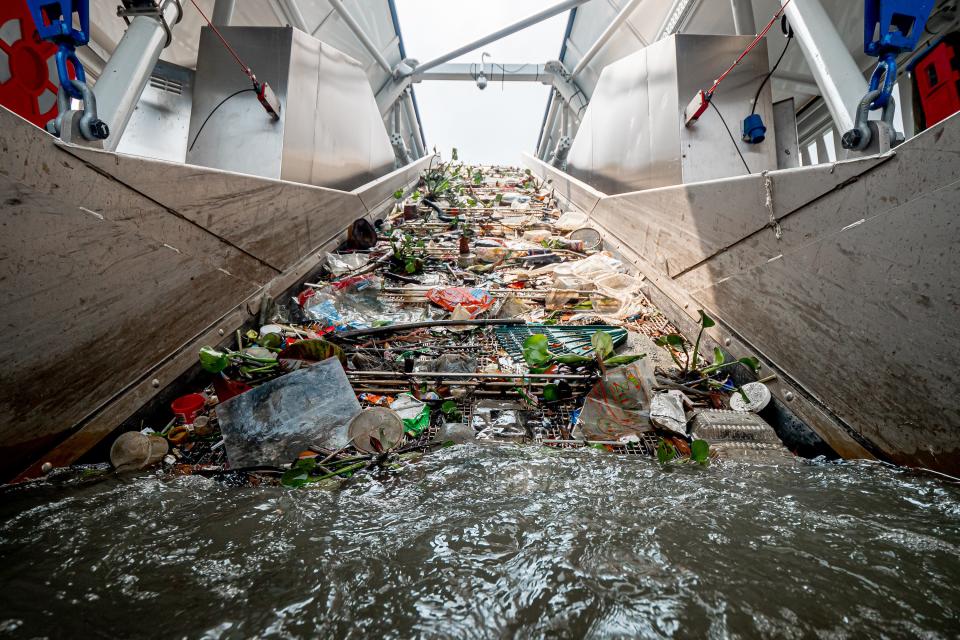The Ocean Cleanups Latest Invention Collects 110,000 Pounds of Trash From Rivers Each Day
Dubbed the Interceptor, this boat is designed to collect plastic trash as it floats down rivers and into the sea. The vessel is the latest project from The Ocean Cleanup, a Dutch nonprofit organization helmed by eco-engineering wunderkind Boyan Slat, whose goal is no less than a 90-percent reduction of plastic trash in the world’s oceans by 2040, and is possibly the most realistic to date.
“Though our initial efforts have focused on addressing the massive amount of plastic debris that has collected in the five ocean gyres, of which the Great Pacific Garbage Patch is the largest, we also need to attack it at its source—rivers.” said Joost Dubois, Head of Communications at The Ocean Cleanup. The Interceptor, which was unveiled in Rotterdam, Netherlands, in October, is a solar-powered trash-collecting barge. Once the vessel is anchored to the riverbed, it lies in wait for plastic trash to float down river into its collection system, where a series of conveyor belts scoop debris from the water and fill dumpsters, which can be removed for recycling.
Founded in 2013 by Slat, The Ocean Cleanup aims to solve the problem of plastic pollution in the world’s oceans by using a fleet of high-technology floating trash collectors. The then 18-year-old Slat was inspired to dedicate his life to cleaning up the ocean after a scuba-diving expedition on which he saw more plastic trash than wildlife. After quitting his astrophysics degree to focus on ocean cleanup full-time, Slat attracted international attention for a series of proposals to collect and recycle trash from the Great Pacific Garbage Patch.

The plan involved an automated system that would create a floating artificial coastline to catch plastic as it drifted on ocean currents. What followed was a $20 million experiment that didn’t quite work, providing the organization not with the ecological breakthrough they had envisioned, but instead with what Slat gamely called “unscheduled learning opportunities.” An updated, and simplified, version of that first prototype, dubbed System 001/B, has finally begun collecting plastic in the Pacific Ocean.
Compared to Slat’s other experiments, the Interceptor aims to collect low-hanging fruit, plastic trash, as it floats down the world’s most polluted rivers before reaching the sea. The Ocean Cleanup has determined that only 1,000 rivers are responsible for roughly 80 percent of riverine trash pollution worldwide, meaning that its vessels can have a large impact on the health of the world’s oceans by focusing on only the world’s most polluted rivers.
Besides, as Slat and his team have learned, it’s much easier to monitor, fine-tune, and operate a high-tech autonomous water-cleaning vessel when it’s anchored a dozen yards from shore near a metropolitan area than when it’s thousands of miles out at sea. So far, the machine is promising, four Interceptors have already been built, and two are operational, one on the Klang River that flows through Kuala Lumpur, Malaysia, and one on the Cengkareng Drain, which flows through Jakarta, Indonesia. The other two are destined for Vietnam and the Dominican Republic.

The hypermodern looking vessels are an incongruous sight on the muddy, slow-moving rivers of Southeast Asia; they call to mind a sort of sci-fi Mississippi riverboat that never beats past the current upstream. Outfitted with lithium-ion batteries and an array of solar panels, the Interceptors can operate day or night, without producing noise or pollution. In fact, the river does most of the work for them.
A floating arm extends into the river’s current to catch plastic and direct it into the Interceptor’s open maw, where it is hauled from the water by conveyor belt into modular receptacles that can be sent for recycling. The organization estimates that a single Interceptor could remove as much as 110,000 pounds of plastic trash a day from a polluted river, and claims that because the arm will not completely span the river, it will not impede boat traffic or local wildlife. The idea is to implement the Interceptor as a scalable solution that can be mass-produced to meet needs around the world.
Originally Appeared on Architectural Digest

